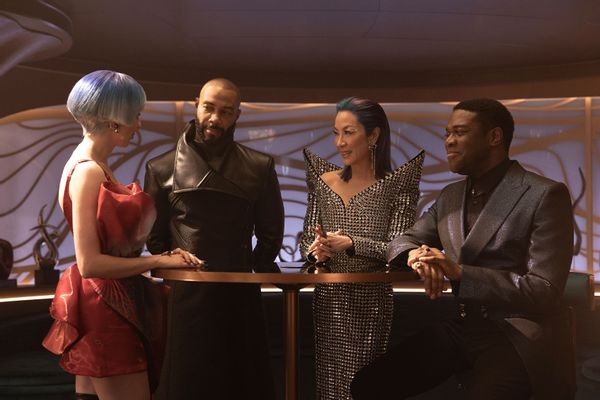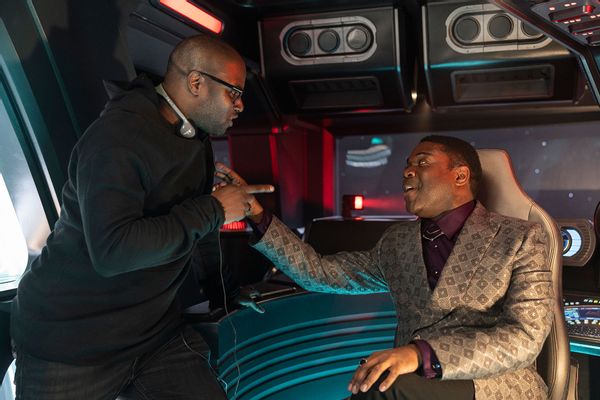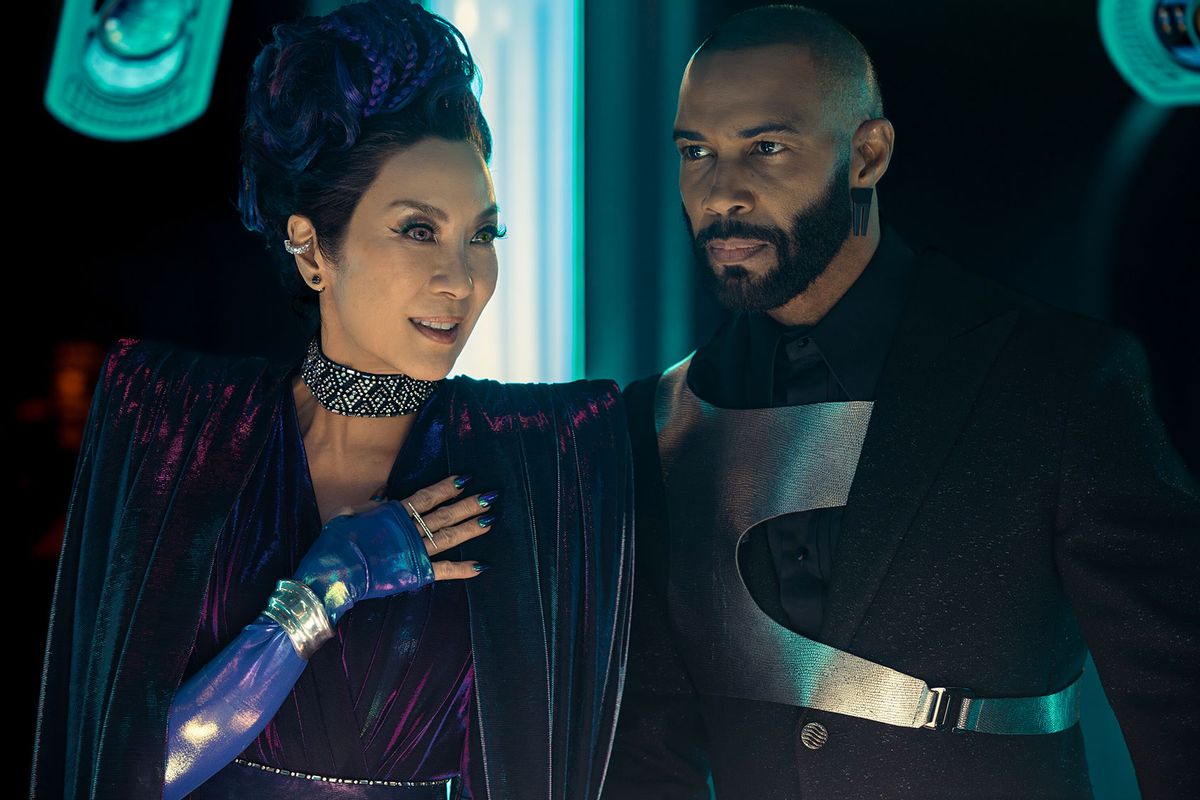Section 31 has been a sorely divisive concept for “Star Trek” fans ever since it was introduced in “Deep Space Nine.” Some view its the covert, autonomous organization's existence as contradictory to Gene Roddenberry’s vision of a utopian future, where the United Federation of Planets is guided by a sense of scientific exploration, cultural openness and acceptance.
What need would an evolved society have for a clandestine branch of special agents greenlit to engage in subterfuge, assassinations, and other grim dirty work? Starfleet has its own sanctioned intelligence subject that works within the rulebook; that’s fair. Black-ops agents empowered to complete their missions by any means necessary are so 21st century.
“This idea of the Federation and all of its perfection and all of its beauty is wonderful, except the light can only exist with shadow. And who are the people in shadow who have to do the work to keep the light present? That is obviously a very relevant topic now.”
But you can almost hear Michelle Yeoh's Philippa Georgiou arguing that sometimes taking down monstrous foes takes sending other monsters against them, a notion plenty of Trekkies agree with. Peaceful worlds are constantly threatened by lawless criminals, hence the need for a Starfleet charter to include an article allowing for "extraordinary measures to be taken in times of extreme threat." Plus, who wouldn’t want to enjoy fresh action scenes starring Yeoh, one of the few recent Oscar winners who can also kick a biped in the face?
All this is to say, “Star Trek: Section 31” was saddled with an impossible degree of difficulty from the jump. Building a universally pleasing story around Section 31 might be the Kobayashi Maru of the Trek universe — a no-win situation. Director Olatunde Osunsanmi and his fellow executive producer Alex Kurtzman know that.
“What we talk about in every iteration of ‘Star Trek,’ be it ‘Section 31’ or the conversations that we're having on ‘Starfleet Academy’ or ‘Strange New Worlds,’ which really is harkening back to the original series in many ways . . . is, how does this story reflect a conversation that's happening now?” Kurtzman told Salon in an interview he shared with Osunsanmi. “This idea of the Federation and all of its perfection and all of its beauty is wonderful, except the light can only exist with shadow. And who are the people in shadow who have to do the work to keep the light present? That is obviously a very relevant topic now.”
Although “Section 31” was originally pitched as a series, the movie finds Georgiou tending an elegant lounge where anything goes located outside of Federation space. More than this, it’s set during The Lost Era set in the Prime timeline years between the end of “Star Trek VI: The Undiscovered Country” and the beginning of the events chronicled in “Star Trek: The Next Generation.”
The Georgiou we know from “Star Trek: Discovery” hails from the Mirror Universe, where she was a genocidal leader of the Terran Empire – a sinister past of which we’re brutally reminded in the opening scenes of “Section 31.” And it’s that side of her that Section 31 needs, sending Alok (Omari Hardwick) and his team to recruit her on a mission to avert an existential crisis – the classic spy game specialty.
Craig Sweeny wrote the story as a one-off, with the idea that any newcomer to the “Trek” universe could drop into this story and understand what’s going on. Sweetening that notion are the references and Easter eggs, including a significant one that nods at Yeoh’s most famous movie in recent years, scattered throughout the story.
Still, it might be helpful to know that once Georgiou crossed over to the Prime Universe with Michael Burnham and the Discovery crew, her arc became one of self-examination and, eventually, a chance at redemption.
“Discovery” walks us through that evolution over several seasons; “Section 31” doesn’t have as much time. Alok’s role, then, aside from bringing Georgiou in from the cold, is to tug Georgiou’s empathy out of deep storage.
 Omari Hardwick as Alok, Michelle Yeoh as Georgiou and Sam Richardson as Quasi in "Star Trek: Section 31" (Jan Thijs/Paramount+)
Omari Hardwick as Alok, Michelle Yeoh as Georgiou and Sam Richardson as Quasi in "Star Trek: Section 31" (Jan Thijs/Paramount+)
Osunsanmi could have played up the anguished side of Yeoh’s antihero – and Hardwick’s, since he has plenty of red in his ledger too. “’Section 31’ could go really dark, and there was a darker hue to some of the episodes taken from the ‘Deep Space Nine’ era and even the ‘Discovery’ era,” he said. “But that's not what we wanted to do here."
“We wanted people, when they walked away, for the word that would pop into their minds and out their mouths to be, ‘fun,’” he continued. “We wanted to put them on a roller coaster, and we really felt that there was room within the Trek Universe for that particular flavor.”
Every version of “Star Trek” that’s debuted since “Discovery” has played with the idea of what is or is not “Star Trek.” “Section 31” challenges those sensibilities by taking Georgiou, a serious character, and reeling her into what is essentially an “Oceans 11” heist film.
Surrounding Yeoh with a cast of familiar actors may ease skeptics into that mission. Joining Georgiou are Sam Richardson, who guest starred in “Ted Lasso” and "Veep,” along with Kacey Rohl, who “Hannibal” viewers may remember as a teen psychopath. Robert Kazinsky’s part as a team’s mech-enhanced muscle is reminiscent of his role in “Pacific Rim.” Sven Ruygrok and “Ginny & Georgia” star Humberly Gonzalez round out the team.
We need your help to stay independent
But it’s Hardwick who may bring the largest fanbase with him to “Section 31,” owing to the six seasons he spent playing James "Ghost" St. Patrick in Starz’s hit drama “Power."
“Alok and Georgiou are “really mirrors of each other, you know,” Kurtzman observed. “They're both characters who were in different ways, forced to become the people that they are.”
Hardwick also understands too well what it’s like to be viewed in a certain way forevermore, despite “Power” having left the air five years ago. “You have certain fans who can never see me and not see Ghost,” he said in a separate interview citing, for example, a fan who came up to him at the grocery store while he was with his kids and joked, “You’re not dead.”
“In front of my children, and that's really difficult to hear,” he admits. “There are certain fans that are just, you know, fan can go to fanatic.” But he also stressed the importance of maintaining what he described as the conversation he began with his fan base who loved him as Ghost through Alok, his “Section 31” team leader.
“I think a lot of fans really do struggle, and I'm getting better at embracing the empathy for that, that they want what they want, he said.
 Director Olatunde Osunsanmi and Sam Richardson as Quasi in "Star Trek: Section 31" (Jan Thijs/Paramount+)
Director Olatunde Osunsanmi and Sam Richardson as Quasi in "Star Trek: Section 31" (Jan Thijs/Paramount+)
Hardwick, Osunsanmi and Kurtzman all express some version of that opinion, although as the guy responsible for overseeing the newest series in “Star Trek” franchise, Kurtzman is used to standing his ground in the eternal argument over what is or isn’t “Star Trek.”
To him, “Section 31” fits into the universe because it’s about outsiders, the types of people Trekkies can relate to more than most. “We're making a show about misfits who don't necessarily fit into a Federation starship, where they've gone to Starfleet Academy and they put on uniforms every day,” he proposes. “But they want the same thing, which is to protect a better future, a future where our angels have led us to our best selves. It's very much a conversation, just a different conversation about all the things that ‘Star Trek’ has always been about.”
Want a daily wrap-up of all the news and commentary Salon has to offer? Subscribe to our morning newsletter, Crash Course.
Osunsanmi’s view is more complex, citing the levels of an argument that spans the show whose fictional characters critique the morality of Section 31; the fans who believe the notion goes against Roddenberry’s philosophy; and within countries who decry the influence that unofficial agencies and their acts can wield over governments.
“It's an argument that occurs across at least three different spheres, so it's very meta for me, and I think a very necessary conversation to have,” the director said. “And you can get into some, you know, some dark territories when you're talking about this type of stuff, which is why it was really important for us to have a bit of a lighter tone in approaching how we came about doing ‘Section 31.’”
Kurtzman added that while the movie is simply that, it ends in a way that lends itself to tell “infinite combinations of stories . . . We'd love to do more. Michelle would love to do more,” he said.
“The fans, equally, are basically stuck sometimes, and I guess it's our job to subtly, not forcefully, unstick them,” he said. “You have to subtly go, ‘Can we try to go this way?' . . . And perhaps slowly but surely, they'll go, ‘OK, I'll give it a shot.’ As long as people give you a shot, I think you're okay.”
"Star Trek: Section 31" premieres Friday, January 24 on Paramount+.
Read more
about this topic



Shares